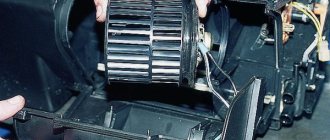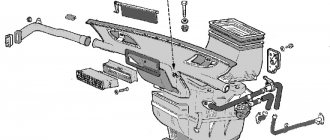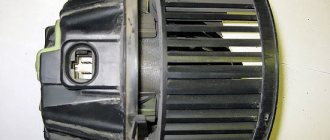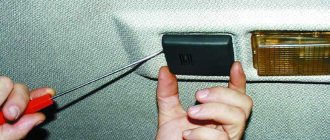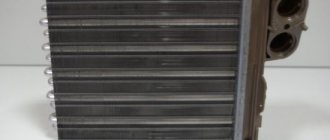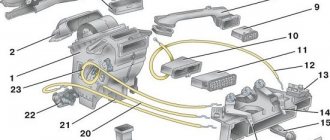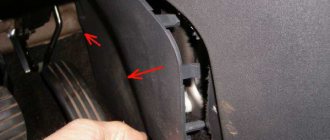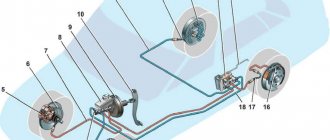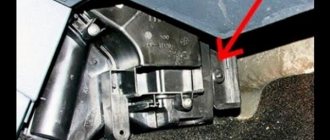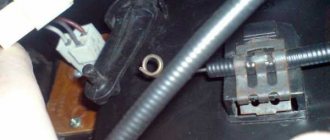Why does a resistor fail?
The cause of resistor failure is burnout.
The fact is that it is constantly energized and transmits current. Experienced craftsmen, however, claim that the failure of the resistor may be associated with malfunctions or contamination of the fan as a whole. When the resistor fails, all the electric current goes directly to the fan, and it only operates at the fourth, maximum speed. Therefore, diagnosing this breakdown will not be difficult for a car enthusiast.
Heating, ventilation and air conditioning control unit Renault Logan, Sandero
The intensity of the air supply into the cabin is regulated by turning the handle of the fan operating mode switch (with the ignition on). This turns on one of four fan speeds.
Heating, ventilation and air conditioning control unit
: 1 – air flow distribution regulator; 2 – air conditioner switch; 3 – fan operating mode switch; 4 – control lever for air recirculation mode; 5 – air temperature regulator By turning the switch handle clockwise, we increase the fan rotation speed. The flow distribution regulator sets the following directions of air flow in the cabin:
– in the area where the head is located
. The air flow through the deflectors in the instrument panel enters the upper part of the car;
– in the area where the legs and head are located
. The air flow enters through the deflectors into the upper part of the car interior and into the footwell area;
– in the area where the legs are located
. The air flow only enters the foot area;
– in the foot area and for blowing the windshield and front door windows
. The air flow enters the footwell area, as well as to the windshield and front door window vents;
– for blowing the windshield and front door windows
. The air flow flows only to the windshield and front door window vents.
By turning the handle of the air temperature regulator, we change the temperature of the air entering the cabin. To increase the air temperature, turn the regulator handle clockwise, to the red sector of the scale, and to decrease the air temperature, turn it counterclockwise, to the blue sector. To allow outside air to enter the cabin, move the air recirculation control lever to the extreme right position. To turn on the air recirculation mode, move the control lever to the extreme left position. The air recirculation mode (cutting off the supply of outside air to the cabin) is recommended to be used when it is necessary to quickly reduce or increase the air temperature in the cabin, as well as when driving in dusty areas or in dense traffic to avoid dust or exhaust gases entering the cabin.
Use recirculation mode with the door windows up. It is not recommended to use the recirculation mode for a long time, as this can lead to an increase in air humidity in the cabin and fogging of the windows. Air can enter the cabin through the central or side vents of the heating, ventilation and air conditioning system. To get air into the cabin...
...open the deflector by pressing its curtain. To change the direction of air flow...
...turn the deflector in the appropriate direction. To protect the windshield and door windows from fogging in the warm season, it is enough to direct cold air at them. To do this, you need to: – use the flow distribution regulator to direct the air through the upper windshield blower grille and the front door glass blower grilles; – move the air recirculation control lever to the extreme right position; – move the temperature regulator handle to the blue sector; – turn on the appropriate fan mode. To clear the windows of ice and snow, we direct heated air onto them by moving the air temperature control knob to the red sector and turning on the required fan operating mode. After defrosting the windows, use the air flow distribution regulator to select the desired direction of air supply to the cabin. To speed up the heating of the interior, it is recommended to turn on the recirculation mode when the car is stationary, and turn it off when driving.
Possible causes of Renault Logan heater failure
Owners of Renault Logan cars often encounter the following problems: the heater does not heat up or cold air comes out of the deflators, although the pipes (the same ones through which the coolant, heated by the engine, goes to the heater radiator) are hot. There may be several explanations for this phenomenon:
- an air plug has accumulated in the pipe;
- Cabin filters or radiator cap are clogged;
- fuses have become unusable;
- low-quality/used antifreeze or insufficient coolant level;
- the antifreeze expansion tank has become unusable (usually after 100 thousand km), or its cap is loosely secured.
Currently reading: Front suspension in a Logan car
Diagnosis of heater radiator malfunction
Replacing the heater radiator may be required in two main cases:
- radiator leak. Signs of a leak are the appearance of antifreeze on the carpet in front (under the feet of the driver and passenger), as well as a drop in the coolant level in the expansion tank;
- ineffective operation of the radiator caused by its clogging. In this case, with the engine warmed up to operating temperature, the heater heats up weakly, and the air flow from it becomes hot only at high engine speeds.
If you identify these malfunctions, you should not be upset; you can do the work of replacing the stove radiator yourself in a garage.
Replacing the heater light bulb
The main problem with a faulty light bulb is that it can signal that the stove is not working, although the heater will function normally.
To change a light bulb you need:
- Remove the radio cover and the buttons that control the operation of the stove.
- Unscrew the fasteners of the module and press in its lower part, and pull the upper part towards you.
- Find the latches on the sides and press them out.
- Unscrew the panel and look for the burnt out light bulb.
- Replace the light bulb and perform all manipulations in reverse order.
Reasons for replacing heating radiators in Renault Logan
There may be two reasons why a car owner will have to change the heating radiator:
- The heater radiator is leaking;
- The heater radiator is clogged.
Leaks in heating radiators occur due to mechanical damage or corrosion. Most often, a leak occurs where the heat exchanger tubes are soldered to the radiator tank. But if the radiator is subjected to shock or very strong and prolonged vibration, then cracks can occur anywhere in this device.
Leaks in Renault Logan heating radiators occur from mechanical damage and strong vibration
Clogged radiator channels are the second reason for replacing the radiator. It takes a lot of time for these channels to become clogged with dirt to the point of complete obstruction, and this malfunction can only be identified by elimination. If all components of the heating system are working normally, but the stove still does not heat, then the problem is a clogged radiator, which is time to replace.
Replacing the heater radiator for Renault Logan, Sandero, Largus
Radiator replacement
heater on
Renault Logan
,Sandero,Lada Largus Great knowledge about Renault...
The reason for the poor performance of the stove on Renault Logan, Sandero, Duster, Largus
Why the stove
does not heat well
Renault
Logan Sandero, Lada Largus, Nissan Almera G15, you can find out from this...
If the Renault Logan radiator is clogged, it is almost impossible to wash it
How does the Renault Logan heater work?
Air enters the car interior - both naturally and with the help of a fan. Air coming from outside can pass through the radiator, thereby heating up, or past it. This depends on the position of the damper, which is connected to the temperature controller.
The radiator heats the air entering the cabin. This occurs due to the circulation, oddly enough, of coolant. It removes heat from the running engine, heats up and, in a heated state, flows through special pipes to the radiator. The maximum heating temperature can be up to 100 degrees - the system is closed and under pressure, which allows it to withstand such loads.
Heated air enters the cabin through deflectors - special openings located in the center and sides of the instrument panel. The air supply intensity is regulated using the heater control unit.
How does the stove of a Renault Logan car work?
The interior heating device on the Renault Logan is located under the dashboard in the central part. The main design elements are a fan, dampers for air flow distribution and a radiator. Failure of one or another part leads to partial or complete loss of functionality of the unit. If you are the owner of a Renault Logan, it would be a good idea to understand how interior heating works.
Schematic representation of the Renault Logan stove: 5 - Distribution block; 6 - Heater radiator; 7 - Heater pipelines; 8 — Passenger compartment fan resistor; 9 — Front left air duct for heating the footwell; 10 — Air recirculation control cable; 11 — Air distribution control cable; 12 — Air temperature control cable
Air can enter the car in two ways: natural, and with the help of a fan. When air enters from outside, it is heated through or past the radiator. The choice of one mode or another depends on the position of the damper, which has a direct connection with the temperature controller. Due to the fact that the liquid in the engine cooling system constantly circulates, the air is heated by the heater radiator. The presence of special air ducts in the center and on the sides of the dashboard facilitates the flow of air into the cabin. How intense its supply will be depends on the adjustments of the control unit.
Heater motor location: 13 — Passenger compartment fan; 14 — Front right air duct for heating the footwell
What is a stove resistor and what is it used for?
If we consider a resistor from the point of view of physics, then this element in an electrical circuit is classified as passive. At the same time, he is assigned various functions depending on the assigned tasks. Thus, a resistor can not only limit the current, but also play the role of a current-to-voltage converter or vice versa. In the design of a car heater, an element is used to regulate the rotation speed of the motor, ensuring current distribution in such a way that the fan has four rotation speeds.
A resistor is used to adjust the rotation speed of the stove motor.
How does the heating system work?
The principle by which the heating system for Renault Logan is designed has long been used by the automaker. The heater radiator is connected to the engine cooling system. Hot antifreeze circulates in it. The entry of heated air into the cabin through the air ducts is controlled by a damper controlled by a cable drive.
The fan can operate in four modes. Voltage is supplied to the fan contacts using a relay. The rotation speed is adjusted using a resistor, which is located in the device switching circuit. You can find this part behind the front panel trim, where the driver’s right foot is located. The resistor is white, and if you look under the panel you can easily find it.
To find the location of the relay, just open the hood of the Renault Logan. A mounting block is installed near the negative terminal of the battery. Here is the part you are looking for. To protect the electrical circuit for switching on the ventilation system, a 30 ampere fuse is installed. It is located in the mounting block, but located in the car interior.
Currently reading: Checking Logan engine mounts
Composition of the Renault Logan ventilation/heating system
Vehicle equipment may vary. In the budget segment, there are models equipped only with a ventilation/heating system; in top configurations there is a full-fledged climate system, supplemented by a car air conditioner.
But if the latter is designed to create a comfortable TV microclimate during the hot season, then the stove and its components included in the cooling system of the power unit are responsible for heating the cabin.
Let's consider the composition of the car's ventilation/heating system, since the second cannot work without the first, being its component integrated into the overall circuit of the air conditioning system.
The Renault Logan heater circuit includes a radiator acting as a heat exchanger (it is often called a stove), an electric fan, and a system of air ducts connected to deflectors. A cabin filter can be included in this circuit. Although it is designed to clean the outside air entering the cabin from various pollutants, it can indirectly affect the operation of the heater.
The deflectors are designed to blow air into specific areas of the car: the windshield/front side windows, the footwell area and the top of the car interior.
Renault Logan heater housing
Climate control unit
On the central console of the dashboard (instrument panel) there is a block that controls the operation of the stove and ventilation system. It includes three handles and buttons for turning on the car air conditioning and recirculation mode:
- on the left is a regulator responsible for the distribution of air flows;
- in the center there is a fan speed control;
- the right handle is responsible for regulating the temperature of the air blowing from the deflectors;
- Between the left and middle handles there is a button to turn on the car air conditioner;
- On the right is the lever for turning on the recirculation mode.
The first two regulators are characterized by a discrete operating mode, the third – by smooth adjustment.
The air flow distribution regulator operates in the following modes, indicated by the corresponding generally accepted pictograms:
- blowing the windshield and front door windows (the corresponding air ducts are activated);
- airflow to the driver/front passenger head area using a central deflector;
- blowing simultaneously the upper and lower parts of the cabin;
- airing only the legs, while there are air ducts passing through the central tunnel to the rear row of seats;
- blowing the legs, windshield/side windows of the car.
The intensity of the air flow entering the cabin is regulated by a central regulator with five positions - “off” and four speeds of rotation of the fan motor. In this case, the electric motor itself rotates at a stationary, maximum speed, and the intensity of rotation of the motor shaft is reduced by means of additional resistors that reduce the current supplied to the motor contacts.
Renault Logan interior heater resistor
The temperature regulator of the air directed into the cabin operates through a rod in the form of a cable, which closes the hole through which hot antifreeze enters the stove radiator. By rotating the handle clockwise into the area of red circles with increasing diameter, we open the tap, helping to increase the flow of antifreeze flowing through the radiator honeycombs, thereby increasing the heating of the air.
The recirculation mode button allows you to completely shut off the supply of outside air to the cabin, which can be useful when driving through heavily polluted/dusty sections of the highway. In this way, you can also quickly and without opening the car windows regulate the microclimate, increasing or decreasing the temperature inside the cabin.
The recirculation mode is activated by moving the lever to the left position. The opposite position of the lever opens the damper for access of outside air along the fan-radiator-air ducts-deflectors chain.
Note that the recirculation mode should not be used for any long time, since in the absence of access to fresh air, the internal air, as a result of the breathing of people in the car, is quickly saturated with moisture, which leads to fogging of the windows. Therefore, it is recommended to use this mode with the windows slightly open, unless it is used to protect against the penetration of dust, pollen, poplar fluff or unpleasant odors into the interior.
Recommendations for preventing glass fogging, applicable in the warm season:
- switch the air flow distribution wheel to the position corresponding to blowing the windshield/front side windows;
- turn off the recirculation mode;
- set the air temperature regulator wheel to the “cold” mode towards the lower blue sector;
- turn on the maximum or third speed of the furnace fan.
As soon as the glass thaws, you can use the switches of the stove control unit to the most favorable operating mode for you. If the car is warming up, the recirculation mode will help speed up this process, but when driving it should be turned off.
Renault Logan heater engine
Heater radiator
It is this device that is responsible for heating the air that enters the cabin. Usually the term “stove” refers to a radiator that acts as a heat exchanger. It is located in the lower part of the power unit, with access to the heater from the passenger compartment, in the area of the central instrument panel. The air duct system runs under the power transverse beam of the torpedo. The radiator itself is mounted in a plastic case, where, in addition to it, there is a fan and dampers that distribute air flows in the required directions.
The radiator is a system of tubes and plates between them, connected into a single whole. The same design is used in the main radiator, located in front of the engine opposite the radiator grille. In principle, their purpose partially coincides - both devices cool antifreeze, which heats up as it passes through the engine jackets. This is necessary to prevent overheating of the power unit, inevitable due to friction of components rotating at high speed (crankshaft, camshaft). True, in most cases, the front radiator copes well with the task of cooling antifreeze, while the task of the interior radiator is to heat the air entering through the deflectors into the internal volume of the Renault Logan.
Heater radiator Renault Logan
The operating principle of the stove is surprisingly simple, while achieving acceptable heat transfer efficiency. So, after the coolant enters the engine from the main radiator, it heats up to a temperature exceeding 100°C (and does not boil, since this is prevented by the high pressure created in the cooling system line by the pump). This hot liquid then flows through the pipe into the stove radiator. Passing through numerous thin tubes, the water cools, giving off heat not to the air, but heating the metal tubes and plates, which have a much higher thermal conductivity. At this time, the air entering through two front air intakes located on the hood near the windshield passes through the radiator honeycombs, heating up, and moving further along the air ducts. When driving at high speed and in not too cold weather, gravity flow is quite enough to maintain a comfortable microclimate in the cabin. But if it’s frosty outside, you can’t do without forced ventilation, and that’s what the heater fan is responsible for.
As you can see, the operating principle of the heater is extremely simple and is based on the thermodynamic processes known from the school physics course.
Heater fan
It is impossible to imagine the design of the Renault Logan stove without a fan. In its absence, the stove is not able to warm up the Renault Logan interior in cold weather. As already noted, this block is located in the radiator housing, in its upper part. Air from the air intakes enters the housing through two holes located on both sides of the decorative trim of the engine compartment bulkhead. When the fan motor is turned off, circulation occurs by gravity, which is not enough to create sufficient pressure even when the machine is moving at high speeds. The rotating blades of the impeller form a noticeable pressure difference, due to which the speed and power of the air flow is regulated.
Heater impeller for Renault Logan
The fan is a prefabricated structure consisting of:
- the motor itself is compact in size, powered by a generator when the engine is running and from the battery when the engine is switched off,
- impellers, shaped like the blades of an aircraft jet engine. It is made of plastic and mounted on the same shaft as the engine.
The rotation speed of the motor is controlled by a handle, which, in turn, closes the contacts of the corresponding step-down resistor. In Renault Logan, in addition to the maximum speed, there are three reduced speeds - this is quite enough to select the optimal airflow mode.
Other heating system elements
If outside air enters the cabin, and in large volumes, then it must go somewhere. This is the responsibility of the ventilation holes mounted in the upper part of the sides of the luggage compartment, which lead to the sides of the rear bumper, bypassing the valves that are closed when there is no circulation of interior air.
Also worth mentioning is the thermostat - a device that is responsible for switching between large and small circuit modes, ensuring quick warm-up of the engine by blocking the circulation route affecting the main radiator. In this case, antifreeze gets into the stove in any case. It could be argued that the thermostat does not affect the functioning of the Renault Logan heater, but this is not so: with a small circle, the heater radiator warms up more, and if the thermostat is stuck in the open position, it is at the stage of warming up the power unit and when driving at low speeds it does not receive enough heat .
Exactly the same can be said about the water pump, which circulates antifreeze through the line under pressure. If for some reason the pump does not operate at full capacity, the heater radiator will again experience a shortage of coolant and will not be able to warm up as expected.
It is also worth mentioning the pipes through which antifreeze is supplied to all components of the cooling/ventilation system. When they depressurize, coolant leaks, which also affects the operation of the stove. In this case, air pockets may occur that impede the normal flow of fluid, and the heater radiator is one of the common places where such troubles are located.
Radiator fault
Another common reason why the stove does not heat properly lies in the radiator. This part of the heating system cannot be repaired due to its thin design. If any faults are detected, the radiator will require replacement. After purchasing a new part, you can begin to remove the old one.
The procedure is simple and consists of the following steps:
- First of all, you need to drain the coolant. Otherwise, it may stain the interior in the future.
- The next step is to disconnect the pipes in the engine compartment. The crimp clamps will have to be replaced.
- To be on the safe side, you should bleed the radiator to remove any remaining coolant.
- Remove the floor covering.
- Remove the radio or plug.
- Remove the center trim of the instrument panel.
- Remove the steering column cover.
- Remove the instrument cluster and its trim.
- Tighten the nuts of the panel reinforcement and remove it.
- Unscrew the screw securing the pipes.
- Unscrew the screws securing the heating radiator, release the latches of the heater housing and remove the device.
The old device can be consigned to the abyss of history. With the new one, do the same steps, but in reverse order. After a simple procedure, the stove heats up again.
Do-it-yourself dismantling and replacement of the Renault Logan stove
The stove is an integral part of the heating system of any car. Thanks to this device, comfort is ensured inside the vehicle during the cold season. As coolant circulates through the heater radiator, the air passing through it heats up. Through the fan and air ducts, heat is supplied and distributed throughout the cabin. Only with a fully functioning system will it be warm inside the car, regardless of the weather outside.
Fan fault
In Renault Logan and structurally similar cars, repairing the heater fan must begin with checking the fuse. Before installing a new part, you must make sure that the fan speed switch is working correctly, otherwise you will need to replace it again. You can find the fuse in the interior mounting block. It is marked in green, and on the Renault electrical diagram it is designated as F36.
If the stove does not heat or does not work well, making a crunching or squeaking sound, then you will have to carry out repairs. In advanced cases, it may come down to a complete replacement of the node.
There is no need to remove the entire Renault Logan dashboard: just unscrew two bolts. The first is located under the facing panel of the right drain, the second is under the plug in the lower right part of the glove compartment. After unscrewing both screws, you need to remove the glove compartment from the guides by pulling it towards you. Be careful not to break anything.
A working fan needs to be cleaned, lubricated and returned to its place, repeating the sequence of actions in reverse order. If the part doesn't work, it will have to be replaced.
Step-by-step instruction
1. Pull the lower casing off the latches and remove it. We take it as shown below and pull it to the sides (towards the doors).
2. Remove the clip to move the carpet aside. The clip can be pryed out with a flat screwdriver.
3. We gained access to the bolts for fastening the strip that supports the rack, and the torpedo is already attached to this rack. The bar must be removed to gain access to the radiator.
Unscrew the two bolts that are marked in the photo below.
4. Squeeze on the sides and push the clip marked below inside. The wiring harness is secured to this clip.
5. Remove the ignition switch connector from the strip. We press the latch and tighten it.
6. After removing the connector, we gain access to the nuts securing the bar. Unscrew the fastening nuts and remove the bar.
When you remove the bar, don’t rush, you still need to disconnect one wiring harness.
7. After removing the strip, we had access to the heater radiator.
8. Unscrew the three Torx T20 screws.
9. Place a rag under the pipes and take them out.
10. Bend the latches and remove the radiator.
The latches literally do not bend, you just need to press them and remove the radiator.
11. Before installing a new radiator, it is advisable to blow out the seat with compressed air or clean it manually.
12. Replace the O-rings on the pipes. After replacing the rings, lubricate them a little so that they fit into the radiator easily.
13. Install the radiator.
14. Fasten the radiator with two screws.
15. Insert the pipes into the radiator and secure the retaining bar with a screw.
16. Next, fill in the coolant, bleed the system, and remove air. We check for leaks in the pipes.
17. If there are no leaks, install a metal strip and the rest. I don't think this needs any details.
Causes of stove malfunction
If it has been noticed that the efficiency of heating the interior of your Renault Logan has decreased, do not immediately panic. First you need to understand in detail what the problem is and find out the reasons. Depending on the nature of the malfunction, the interior heater may work poorly or not function at all. Let's look at the main reasons why the stove's performance is impaired:
- There is an air lock in the heating system.
- Thermostat failure.
- The pump is not working properly.
- The heater radiator is clogged.
- Problems with the heater motor.
Currently reading: Buy a used Renault Logan at a price of 160,000 rubles in Volgograd - more than 74 used Renault Logan on Avto.ru
Despite the apparent simplicity of solving these problems, they are the ones that most often force car owners to carry out independent repairs or contact a service center.
Main malfunctions of stove motors
Most often, the cause of heater motor failure is natural wear and tear of its parts. During long-term operation, metal aging is an inevitable evil, since brushes, rings and bearings have a limited resource. Less often, the motor fails due to electrical problems - for example, broken wires or oxidized contacts. And also, motor malfunction can be caused by a very simple reason - the production of lubricant. Typically, the driver of a Renault Logan car can independently diagnose problems with the motor. The occurrence of malfunctions is judged by the following signs:
- change in the sound of the stove;
- heat output has become uneven and weak;
- The stove is difficult to turn on.
If the operation of the stove does not correspond to the specified settings, this indicates a problem with the motor.
Troubleshooting minor problems
If “alarming symptoms” occur, it is necessary to consistently check the condition of the antifreeze and the vehicle components described above. If air pockets are detected in the system, they must be vented. Clogged filters and caps should be cleaned or replaced. Used antifreeze must be drained and new one added. The expansion tank can also be changed; in this case, it is better to leave the “original” lid - it will hold pressure better.
If the manipulations done do not have an effect, then the problem lies in one of the heater components.
Purpose of the heater radiator for Renault Logan
The heater radiator on the Renault Logan performs the same function as the main radiator of the engine cooling system: it serves as a simple heat exchanger.
Heating radiators on Renault Logan are usually made of aluminum
The principle of its operation is simple. Antifreeze, heated by a hot engine, enters the furnace radiator, which is intensively blown by a small fan that forces hot air from the radiator grilles into special air ducts. Through them, hot air enters the car interior and heats it. The heating intensity is regulated by changing the fan speed and changing the angle of rotation of a special throttle valve for cold air coming from outside.
On a Renault Logan car, the heating radiator is a conventional heat exchanger
Location of the heater radiator in Renault Logan
The heater radiator is located below the dashboard, almost at the level of the cabin floor, near the driver’s right foot. It is not possible to see it, since it is covered on all sides with plastic panels and interior upholstery. And in order to get to the radiator and replace it, all this lining will have to be removed. The main part of the work to replace this device involves dismantling the cladding.
Renault Logan heating system device
The main component of an automobile heating system is the heater heat exchanger, a more common name is the heater radiator. Its purpose is to heat the air entering the car interior to the temperature set by the driver or his passenger. The radiator heats up due to the circulation of antifreeze.
Another component of the heating system is an electrically driven fan. The fan provides air from the street and regulates this process.
The system has a damper for regulating the temperature of the air entering the car interior from the heater. Depending on the angle of rotation of the damper, the amount of air passing through the heat exchanger of the heater and the amount of outside air entering without entering the heat exchanger are regulated.
You can also indicate the presence in the system of dampers for distributing the air flow entering the car interior through air ducts from the heater. Simply put, the air that blows onto the windshield and side windows.
Find out more about the new Logan
- Cleaning the crankcase ventilation system - First maintenance (TO-1) - Renault Logan (Renault Logan) repair and maintenance
- Checking the cooling system - Engine overheating - Renault Logan (Renault Logan) repair and maintenance
- Renault Logan rear wheel bearing size
- Removing and installing the engine - Section 5. Engine - Renault Logan (Renault Logan) repair and maintenance
- Removing, installing and adjusting the hood lock and drive - Hood - Renault Logan (Renault Logan) repair and maintenance
- Interruptions in engine operation - Section 3. Malfunctions along the way - Renault Logan (Renault Logan) repair and maintenance
- Removing the engine from a Renault Logan / Renault Logan
- How to replace the front door lock cylinder of Renault Logan
The heater does not heat
That is, it works, but the air comes out cold or barely warm. It is clearly not enough to warm the driver and his passengers.
There are several reasons why the stove on a Renault Logan may not properly release heat into the cabin.
- Thermostat. This element has failed and is jammed. The thermostat is responsible for circulating the coolant in a large and small circle. If the cooling system thermostat suddenly gets stuck in the large circle circulation position, then the heated antifreeze will not pass through the heater radiator. Consequently, the heat exchanger does not heat up and the fan blows cold air. To solve the problem, you will have to change the thermostat.
- Stove radiator. A typical and quite common problem for Renault Logan cars, as well as for a number of other cars in the Renault line, is a clogged heater radiator. This happens mainly due to the fact that the calming partition in the expansion tank is destroyed. Over time it crumbles. On average, a part is destroyed within 100 thousand kilometers, or 8-10 years of operation. But it happens before. Small debris passes through the internal honeycombs of the radiator, which contributes to clogging of the channels. The trouble with the situation is that the heater radiator will have to be completely replaced. Washing usually does not give the desired result.
- Coolant. Everything is simpler here. The level of coolant in the system drops, causing the heater to stop working properly. It's getting cold inside the Renault Logan. Try adding the missing amount of antifreeze. If the level drops again, check the system for leaks. Obviously, a hose is broken somewhere, the tank is leaking, or the connecting pipe has broken its integrity.
- Airing. When adding fluid, do not forget to bleed the air from the cooling system. When the level drops, air jams often form, which can disrupt the functionality of the car's interior heating system. You can bleed the system by removing the cap from the expansion tank and starting the engine.
- Stove damper. The damper that opens and closes hot air into the cabin may break. This does not happen so often, but this option cannot be ruled out. Due to the damper in the Renault Logan, the stove does not heat the interior in summer and spring, but simply allows outside air to be supplied inside the car. To restore the damper, you will have to partially disassemble the interior. The damper usually breaks due to broken cables or mechanical failures of the drive. As practice shows, the reason is freezing of the damper, or a lack of lubrication between the moving elements of the damper mechanism. Unfortunately, the problem can only be solved by replacement.
- Cabin filter. A banal, but no less common reason. If the baffle filter is clogged, air will not be able to pass through it. At the same time, when the filter is dirty, the windows from inside the car usually begin to fog up.
Surprisingly, sometimes a simple replacement of the cabin filter completely solves the problem that has arisen in the form of a non-working heater.
Replacing the heater fan (heater) for Renault Logan, Sandero, Duster, Lada Largus
Detailed video
- instructions for removing and installing a heater fan (
heater
, air conditioner) without dismantling.
Attention! Before carrying out this work on Renault Logan, you must first drain the antifreeze into a separate container.
- If the Renault Logan water circuit pump does not work correctly, it does not produce the proper pressure, coolant cannot flow into the heater radiator, and accordingly it does not heat the air. A detailed article on how to replace a low beam lamp on a Renault Duster, article numbers are given, there is video and photo content, tips on replacement and selection. This problem usually leads to engine overheating, so the water pump needs to be replaced urgently. Video review on how to remove and install the front bumper on Renault Logan and Lada Largus cars with your own hands. In order to change the water pump, it is necessary to disassemble the gas distribution system and drain the antifreeze in advance.
- If the car was previously operated carelessly, and water was poured into the system instead of antifreeze, corrosion products may well clog the interior heater radiator, which in turn negatively affects its operation.
Unfortunately, cleaning the radiator of the Renault Logan heating system is not practical. How to replace generator bearings for Renault Logan 1.4-1.6 (2008-2014). Replacement instructions, catalog number, dimensions. Video description of the procedure for replacing all lamps in a Renault Logan headlight unit with your own hands. This part needs to be replaced.
To replace this part, it is necessary to disassemble the cabin heater body, first freeing the cooling system from antifreeze.
- This fault can cause air pockets in the cooling system. According to the video for the Renault Logan fan, just like on the Renault, then you need to remove the fan itself. Due to engine overheating, the cylinder head gasket may be damaged, thus allowing gases to enter the water supply system. With the engine running, open the filler neck of the expansion tank and pay attention to the condition of the antifreeze. If air bubbles enter the reservoir, this indicates a faulty cylinder head gasket.
- This problem is due to poor air conductivity by the Renault cabin filter. » Video gallery » Russian rock » eyelashes on a Nissan Tiida (russ-artel.ru), remove a headlight on a Nissan Tiida video how to remove a bumper on a Nissan Tiida eyelashes on the headlights right now and your car will be. Hi all! In today’s post, I want to tell you how to change the rear brake pads on a Renault Megane 2. You can fix this problem by replacing this filter.
- If there is no air flow when you turn on the cabin heater, it is likely that the heater motor is not working. Unfortunately, this unit cannot be repaired; it must be replaced.
- The speed controller is directly connected by an electrical circuit to the fan motor. Therefore, it is worth checking first. (Stoves) for Renault Logan this video is how to remove and repair the Renault heater fan. It is quite possible that it is the regulator that is not working.
- If the above problems do not affect your car, and the stove still does not heat the air, then it is worth checking the radiator taps. It is quite possible that the valves that allow antifreeze to flow to the heater radiator are not working.
